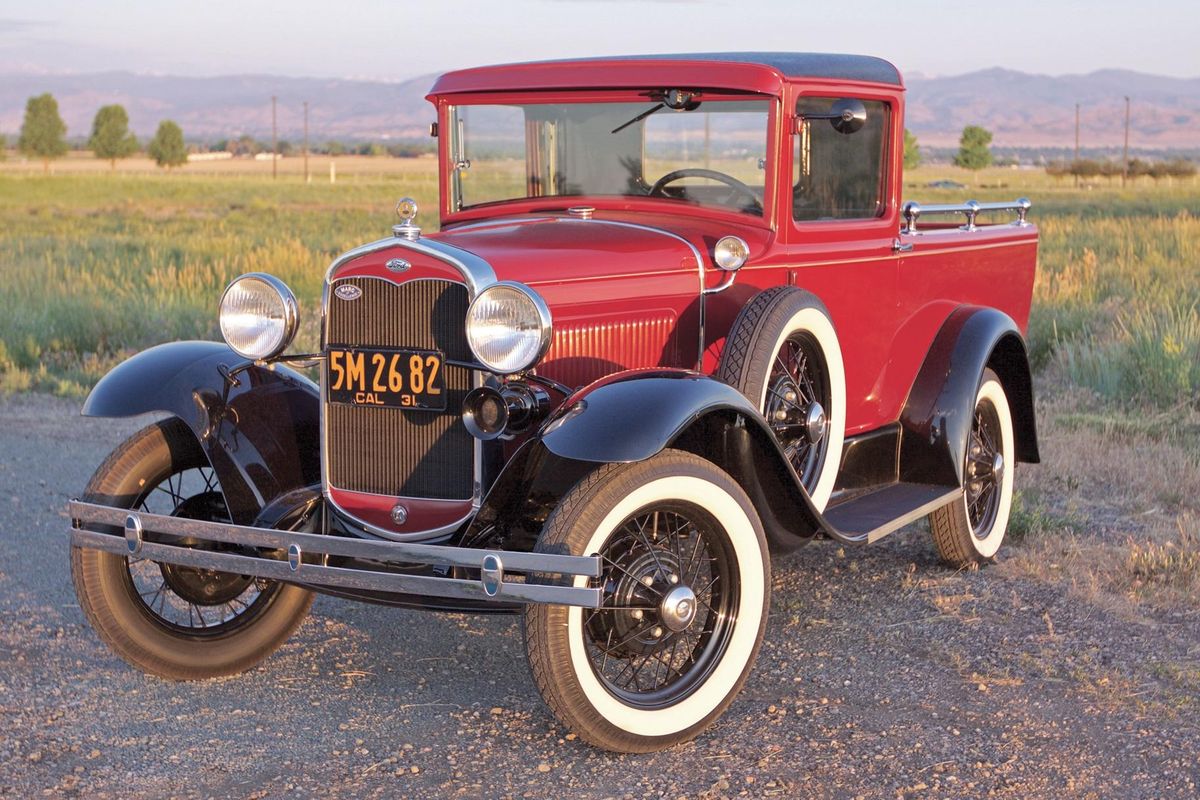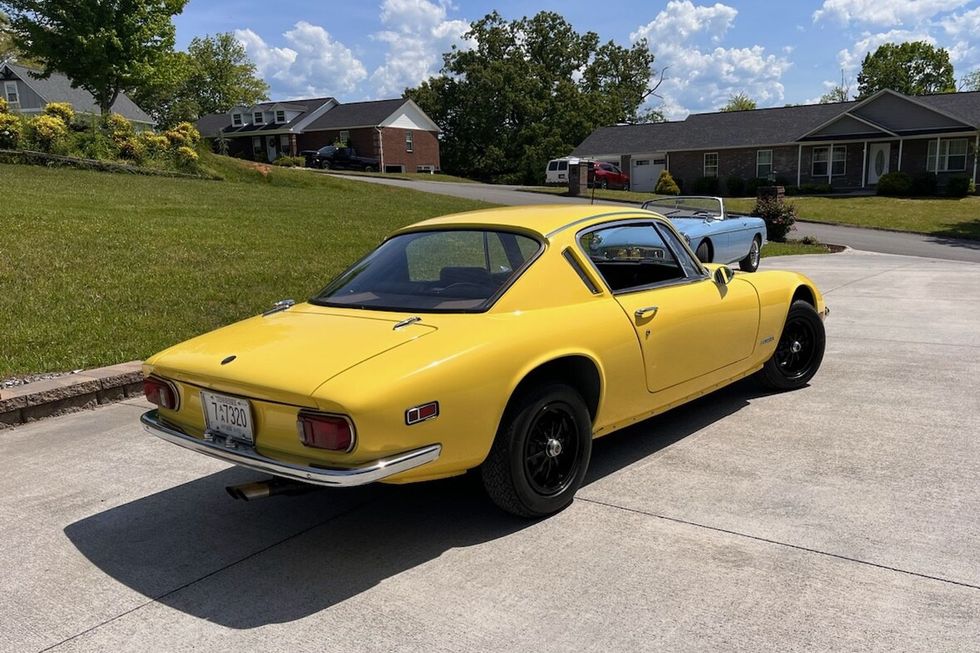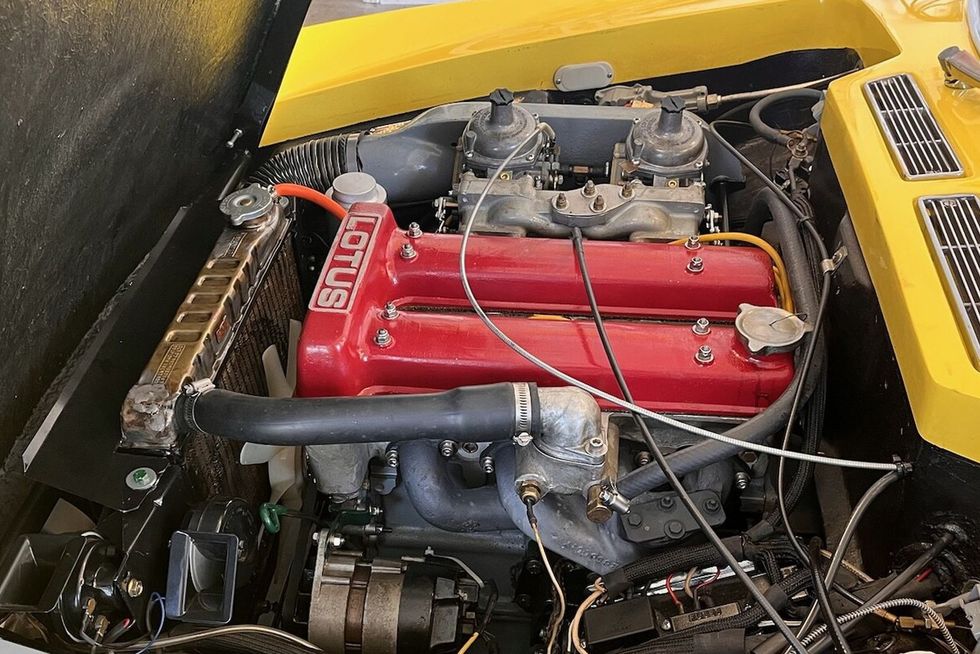Ford’s Formal Freight Mover - 1931 Ford Model A DeLuxe
The 1931 Model A DeLuxe combined high style with hard work
09/23/2018


Ford was dealt a one-two punch in 1931 as rival automakers pounded away at the Model A's dominance and the Great Depression pummeled new-vehicle sales.
Ford was still the low-cost leader, but Chevrolet, Essex, Pontiac, and Willys were offering six-cylinder engines at competitive prices. Moreover, Chrysler's fledgling Plymouth brand had emerged as a serious threat to the A, with a higher-horsepower four-cylinder engine and other advanced features: hydraulic brakes and shocks, "Floating Power" engine mounts to reduce harshness and vibration, and automatically controlled vacuum spark advance.
Over the winter of 1931, Chevrolet overtook Ford in domestic automobile sales and never looked back. Ford finished the year in the number-two position behind Chevrolet, selling nearly 50,000 fewer cars. Where the plucky Bowtie division couldn't top Dearborn, however, was in the commercial vehicle market. In 1931, Ford hung onto the number-one spot in the truck race with a nearly 40,000-unit edge over Chevrolet, despite flagging sales industry-wide.
Of course, we all know the rest of the story: Henry Ford rocked the industry in 1932 with the release of the game-changing 221-cu.in. V-8 that only cost buyers about $50 more than the four-cylinder engine. But in the days before the flathead V-8, Ford was scrambling for new ways to stem market-share losses. Commercial truck sales were key to that strategy, and Dearborn's efforts to create some buzz around Model A pickup trucks brought about some interesting, and now rare, one-year-only designs. Among them, the De Luxe pickup—like the one featured here—with its cab-integrated bed sides and more.
A prototype for the De Luxe pickup was unveiled at a General Electric Refrigerator dealers' convention in March 1931 at the Statler Hotel in St. Louis, Missouri. It was painted white, and bristled with luxury-themed trim and accessories uncommon on trucks, such as a bright radiator shell and cowl band, as well as bright headlamp buckets, windshield frame, and outside rearview mirror. This jaunty one-off truck also had some features that didn't see production, such as twin sidemounted spares with stainless bands, a slanted windshield, and opera lamps on the B pillars.
Ford's publicity photos showed the handsome truck hauling a GE refrigerator— each wearing gleaming white finishes. This idea of an upscale delivery truck to tote its appliances apparently appealed to GE, so Ford placed an initial order of 325 bodies with Briggs Manufacturing. The production pickup, known in Ford factory parlance as 66-A, differed from the show truck, as it used Ford's standard cab with an upright windshield, had only one sidemount spare, and the opera lamps on the cab were eliminated. The signature smooth bed sides remained, however, and the integrated cab-bed look was accomplished with panels that hugged the rear of the cab and were riveted in place. This gentrified A pickup was available not only in white, but in 38 colors offered by Ford.
Unfortunately, this stylized hauler didn't catch fire with truck buyers. Ford sold just 99 by the fall of 1931, and ultimately canceled its order with Briggs after fewer than 300 were produced.
The De Luxe pickup wasn't the only hauler that Ford attempted to take upmarket that year. The De Luxe line also included a De Luxe Delivery and a De Luxe Panel Truck. The Delivery was a Model A panel with bright trim, while the Panel Truck was an AA dressed up with shiny exterior bits. For businesses wanting the most prestigious hauler on the market, there was also a Town Car Delivery with an open cockpit, like a chauffeur-driven rig. Behind the driver was a special rounded enclosed cargo box ornamented with opera lamps and, of course, a full complement of polished trim, including stainless spare-tire bands, rounded out the package. This fancy panel found even fewer takers than the De Luxe Pickup— only 196 were built, making them a rare find today.
When the Model A Pickup arrived for 1928, it was anything but luxurious, and offered only with an open cab capped by a fixed soft-top. The closed-cab truck made its debut in August of that year, but in keeping with its all-business image, exterior colors on all trucks were limited to either black or green. In 1929, Ford's pickups were outfitted with black steering wheels to replace the previous year's red wheel, outside door handles were added on roadsters, and the color palette was expanded to include black, blue, and two shades of green.
The Model A Pickup's one and only facelift came in June of 1930, when the boxy, upright closed cab was replaced with a lower, rounder, more modern-looking design. The restyled trucks also rode on 3 x 19-inch wheels (older Model A's used 21-inch wheels), shod with 4.75- inch tires. Other differences between the 1930-'31 Model A's and earlier Pickups included a taller radiator, a reshaped hood, broader fenders, a reshaped front bumper (rear bumpers were optional), and twist-on gas and radiator caps. While the bed panels were the same through much of the Model A Pickup's run, no other panels interchange between the 1928-'29 trucks and the 1930-'31 trucks.
Driving a Model A pickup today definitely makes you aware of just how far truck sizes have sprawled. The A's cab seems small enough to fit inside the glovebox of a new F-150—two full-sized guys will practically touch shoulders, and driver legroom is scant. To start the truck, you must manually open the throttle and retard the spark using the steering-wheel-mounted levers, turn on the ignition key, pull on the choke, and then engage the starter using the floor-mounted switch (just above the gas pedal). Once the engine starts, you advance the throttle, then work the choke until the engine is warmed up. By turning the choke knob, you can enrich or lean out the air/fuel mixture.
The Model A's three-speed transmission uses a conventional H shifting pattern, but with straight-cut gears, shifting is best performed slowly. When downshifting, you must match your engine rpm to the road speed—double clutching certainly helps. The road manners of these trucks are surprisingly nimble, thanks to stiff suspension and quick steering. A Model A pickup feels happiest running along at around 45 mph, so hanging with traffic on secondary roads is definitely possible.
The owner of this month's feature truck, Ralph Lawrie of Folsom, California, isn't shy about driving and sharing his rare Rubellite Red De Luxe Pickup. "Being in California allows me to go to a show every Wednesday night, or to Saturday morning cars and coffee," he said. "Everyone hasn't seen one of these trucks, so people love to look at it."
Ralph and his wife, Phyllis, own four Model A's, so they have an appreciation for the breed. "This one I bought out of Rochester, New York, in March 2016," he said. "The seller was the second owner. The original owner used it as a service truck for his business from 1931 to 1949, when he put it in storage. The guy I bought it from acquired it in 1962 and took until 1968 to restore it."
Even with its decades-old restoration, the truck proved it had no trouble holding its own on the show field, as Ralph discovered immediately after purchasing it. "I bought it and had it delivered to a friend's house near the upcoming Model A Ford Club of America show in Loveland, Colorado," he said. "I went out there, polished the truck, and then put it in the show. It won first place in the Red Ribbon (Touring Class), rather than the Blue Ribbon (Restored Class), because I didn't have metal valve stems on the wheels."
The whitewall tires, too, Ralph notes, are incorrect for a commercial rig, and he plans to change them. "I'm taking it to a national show in Reno in 2018," he said. "I've got the metal valve stems, but I haven't put them on." Lately, Ralph said he's been preoccupied with finding and adding to his collection that most unusual of 1931 commercial Fords. "I've been in the Model A club for almost 30 years, and I like to look for the unusual cars," he said. "The other rare car I'm trying to buy—there are only seven—is a Town Car Delivery."
Porsche has confirmed the official arrival of its hybrid 911 model, which will see its full debut on Tuesday, May 28. Whether or not sports car enthusiasts and Porsche aficionados accept the new hybrid as the newest 911 model, the sports car’s performance capabilities can’t be denied.
In its press release, Porsche boasted that its engineers logged over 3,000,000 test miles on the new 911. The hybrid was subjected to testing in the Artic Circle’s extreme cold environment and the unbearably hot deserts of Dubai, but Porsche didn’t stop there. Stop-and-go traffic scenarios were vigorously tested for drivers who plan to daily drive their new 911.
Perhaps the most impressive tests took place on the famous Nürburgring circuit. Porsche claims that Le Mans World Champion driver Jörg Bergmeister took the wheel, piloting the hybrid-powered 911 around the course in just 7:16.934 minutes, which is reportedly “8.7 seconds faster than the corresponding version of the predecessor model.”
Porsche has not yet released full performance data for the 2025 911, so it’s difficult to say exactly what those comparisons look like. Since the math makes sense, Porsche could be comparing the hybrid 911 to the 992 Carrera 4 GTS, which lapped the Nürburgring in 7:25.632. What we do know is that the 493-horsepower GT4 RS completed a lap at the Nürburgring in 7:03.121 minutes, just 14 seconds quicker than the road-going hybrid.
“For the first time in our icon’s 61-year history, we are installing a hybrid drive system in a roadgoing 911. This innovative performance hybrid makes the 911 even more dynamic,” Frank Moser, Vice President of 911 and 18 said. “We left nothing to chance during development and tested the new 911 under all sorts of conditions all over the world. Whether at a high drivetrain load in the demanding conditions of mountain passes or in the stop-and-go traffic of an urban environment, the new 911 has mastered even the most difficult challenges with aplomb."
Stay tuned for more details on May 28, when Porsche is scheduled to reveal the beginning of a new era, the hybrid 911 sports car.
In the early 1960s, Lotus debuted the Elan, an extremely lightweight, exceptionally small sports car. With its backbone chassis and fiberglass body, the Elan—available as a roadster or fixed-roof coupe—weighed a little over 1,500 pounds. A Ford Kent-based engine with a twin-cam, 16-valve cylinder head gave the diminutive sports car brisk performance, allowing the tiny Elan to punch well above its weight class. One thing thin the Elan was never noted for, however, was comfort, nor convenience, what with only two seats.
Enter the Elan +2, a much larger car built with the same design and engineering features, but with space for two children in the back and more comfort for the driver and front passenger. The Plus 2 debuted in 1967 and not long after an updated version, the +2S, was released with additional luxuries. Unlike the Elan, the +2 was only ever produced as a coupe. This 1972 Lotus Elan +2S 130 now offered on Hemmings Auctions appears to be a road-ready example of the first four-seater from Lotus. The “130” portion of the name came from the revised, higher-output 126-horsepower engine in the model released in the early 1970s.

Like the original, the Elan +2S featured a backbone frame and a fiberglass body. Though still compact by almost any definition of a car from the 1960s, the four-seater was bigger in every dimension. Lotus designers and engineers were tasked with creating a car that “must be capable of transporting two adults and two children 1,000 miles in comfort with their luggage.” The Plus 2’s 96-inch wheelbase was a foot longer than the original. And its overall length of 169 inches was a full two feet longer than the earlier car. Additionally, it measured 10 inches wider and two inches taller. The Plus 2 was still relatively small, itself measuring one foot shorter in both wheelbase and overall length compared to a 1965 Ford Mustang Hardtop.
Those plus-size dimensions greatly contributed to the comfort inside the car, but with road testers of the day still praising the car for maintaining the Elan’s adroit handling. Motor Sport magazine from the U.K. described the Plus 2’s steering as “incredibly light and precise.” In detail, they wrote, “The all-round independent suspension with its racing-like wishbone and link lay-out gives the car superb handling, of that there is no doubt. The glory of it is that you can whip along country lanes with their twists and turns without drama, in complete safety and not working hard while drivers in lesser vehicles struggle to keep up.”

The “big-valve” version of the 1,558-cc Lotus-designed/Ford-based twin-cam four-cylinder engine in the +2S 130 was rated at 126 horsepower and 113 lb-ft of torque, giving the car brisk acceleration, as it weighed a little over 2,000 pounds. A four-speed manual directed power to the rear wheels. Road testers of the +2S and +2S 130 models reported 0-60 mph times at right around, or even just under, eight seconds.
Technically, by 1972, there was no such model as the Elan +2S. Rather, Lotus dubbed the car the +2S 130, or alternatively the Plus 2 130. In either case, despite the obvious origins and former use of the name with the model, “Elan” was dropped from the moniker by that time. The Elan name did reappear the following year. Though Elan production ceased in 1973, the Elan +2 continued through 1974.

The notes on this 1972 Lotus Elan +2S 130 currently listed on Hemmings Auctions indicate that this Plus 2 has been restored, including a rebuild of its original engine and four-speed manual transmission, completed some 3,000 miles ago. The seller shared that the water, oil and fuel pumps were replaced, while the radiator was rebuilt. Additional fresh components are said to be the brake discs, updated Rotoflex drive couplings and wheel bearings, all as part of a chassis rebuild.
The seller reports that the fiberglass bodied was disassembled, repaired and professionally refinished before reassembly. The original brightwork was rechromed as necessary and the original glass reinstalled with new seals. Fresh Pirelli Cinturato rubber was mounted on refinished original Lotus 10-spoke alloy wheels. According to the Classic Lotus Elan Register, this +2S 130 is one of 1,879 +2S and +2S 130 models built out of a total production run of 5,139 Elan +2’s.
Take a look at this 1972 +2S 130 at Hemmings Auctions to see what a right-sized Lotus Elan looks like.
